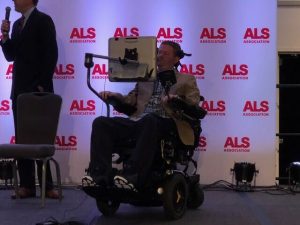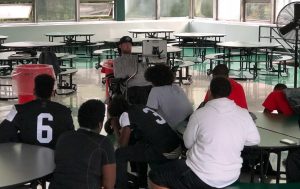Eye-tracking Device Gives Voice to ALS Ice Bucket Challenge Co-founder Pat Quinn

For Pat Quinn, co-founder of the ALS Ice Bucket Challenge, everyday communication has become more challenging as his amyotrophic lateral sclerosis (ALS) disease has progressed. But eye-tracking technology has helped him, in a sense, retain his “voice.”
In fact, Quinn recounts a time when inadvertently letting his device’s battery die directly affected his physical well-being.
“We were driving home, and I have no way to communicate with my caretaker in the back of my van,” Quinn told ALS News Today. “Throughout the two-hour ride, there were numerous times I needed adjustments but could not get his attention. So, I couldn’t get assistance and was uncomfortable for most of the ride. It was a miserable situation.”
The technology
The eye-tracking and eye-control technology upon which Quinn and others depend enables computers to track where the user is looking. When that technology is married with a speech-generating device, people with conditions including ALS, cerebral palsy, spinal cord injury, aphasia, and Rett syndrome can communicate, use the internet, and control their home environment — using just their eyes.
For example, Quinn, who was diagnosed with ALS in 2013, used his device — the Tobii Dynavox I-15+ — to answer emailed questions for this interview. Otherwise, it takes him a relatively long time to use his eyes to type responses. The Yonkers, New York, resident lost his own voice to the progressive neurological disease about three years ago.
“I got [the device] when my arms and hands became too weak to use a keyboard on the computer, or texting on the phone, and I noticed my voice was getting softer,” said Quinn, 37, who has been using the technology for about four years.
“I use it for literally everything — for emailing, texting, phone calls, social media, reading, writing, and more. More importantly, it is my voice. I truly don’t know how progressed ALS patients could function without it,” he said.
ALS is characterized by the deterioration of motor neurons that control voluntary muscle movements. Speech problems, which are common, occur during the early stages and usually worsen as the disease progresses.
The disorder affects nerves and muscles that control movement of the lips, jaw, tongue and vocal cords to the point where proper use becomes difficult. Lack of use also causes some muscles involved in speaking to weaken over time.
“It’s amazing to see the progress each of our users can make when they have the ability to communicate,” Fredrik Ruben, CEO of Tobii Dynavox, said in an email, adding that about 5,200 people with ALS use the company’s products.
“The most simple interaction can mean so much when you give someone a voice when they get a condition like ALS that takes it away. At Tobii Dynavox, we are incredibly proud to provide our users with the ability to have a voice again and work with them throughout their journey with our devices.”
While there are other companies developing speech-generating devices for those who rely on what’s called augmentative and alternative communication (AAC) apps, Tobii Group leads the market. Tobii Dynavox, a division of the company, introduced its new flagship I-series last fall.
In May, the company made social media, streaming, and communication platforms such as Facebook, Instagram, Spotify, WhatsApp, and Netflix more accessible. In collaboration with d-bur, a company specializing in assistive technologies development, Tobii Dynavox developed a way for its Communicator 5 software to interface with the apps. Access previously had been a challenge for individuals using eye tracking.
Most recently, Tobii added outdoor eye-tracking capabilities to its new I-series, giving people with ALS and other disabilities the ability to communicate using only their eyes even when outside in a wide range of light conditions, including bright sunlight. The series also offers Partner Window for face-to-face conversations and Windows Hello for visual logins.
“The eyes are one of the only muscles that are not affected by ALS and because of that, our eye tracking devices make it possible for our users to do things they wouldn’t have been able to do,” Ruben said. “The ability to express yourself, communicate and still do all the things you did before ALS is the greatest benefit for our users.”
The devices range in price from $10,000–$15,000, depending upon selected options; they’re usually covered by insurance.
Quinn calls his device a lifesaver.
“My Tobii Dynavox is in front of me 24/7. It’s my voice, so it’s always needed. When I wake up in the morning, it’s one way I call for assistance. After I get up, it’s how I communicate. It’s how I remain productive. I am very proactive and engaged in the ALS community, so I knew how important it was to get the eye-gaze computer.
“But I can clearly remember the time right before I got it because it was extremely frustrating. I was typing everything on my phone with my right thumb, my only remaining functioning finger, while holding the phone in the palm of my left hand. I would constantly drop the phone, but it was either struggle or be disconnected with the outside world. Tobii changed everything,” he said.
Before he was diagnosed, Quinn, who is single, worked in New York City for a technology recruiting firm. Shortly after his diagnosis, he was accepted into the New York State Trooper Academy.
“It’s important to know I would have made it, but at the same time, it’s devastating ALS took that from me,” he said.
Ice Bucket Challenge
In 2014, Quinn co-founded the ALS Ice Bucket Challenge, which took social media by storm and significantly accelerated the fight against the disease. According to a report from independent research firm RTI International, some $115 million in donations to the ALS Association increased annual global research spending by 187%.
Since the challenge, there also have been upticks in collaborations, scientific advancements, and federal research funding, as well as expansions in care, according to a press release from the ALS Association, the world’s largest private funder of ALS studies.
The challenge started by Quinn and fellow ALS patient Pete Frates, who died last year, encouraged nominated
participants to make a video of themselves having a bucket of ice water poured on their heads, after which they nominated others to complete the challenge. The informal rule was that nominees had 24 hours to follow suit or else they had to donate to a charity. More than $220 million was donated to ALS charities globally.
“I could never have imagined, not in my wildest dreams, that the Ice Bucket Challenge would become this global phenomenon,” Quinn said.
“Every time I thought to myself, this can’t get any bigger, the next day it would somehow get bigger. No one could have imagined what was about to happen. As it happened, my head was spinning. It was surreal. Hundreds of likes on every Facebook post. New videos were being uploaded every couple seconds. Within a week, while you were probably filming your Ice Bucket Challenge in the backyard, so were the biggest athletes, famous celebrities, and even world leaders. The power of this positive movement was life-changing.”
Project Revoice
Quinn also has been involved with Project Revoice, a nonprofit voice-cloning initiative of the ALS Association aimed at ensuring that no one living with ALS will ever have to lose his or her voice. Due to breakthroughs in voice technology, it’s now possible to fully re-create the unique essence of any voice and build a digital voice clone for daily use with AAC devices. As one of the faces of the initiative, Quinn had his voice re-created from past recordings.
“I didn’t know if I would ever be able to speak again in my own voice. Project Revoice has made that possible,” he said. “Being able to communicate to friends and family in my own voice makes me feel like people know these are my words, not some voice in the computer. This is really a project moving forward that will make future patients have one less thing to worry about. I am extremely excited to watch this grow.”
These days, Quinn is basically paralyzed, although he can move his legs a little and turn his head left and right. Still, he continues to stay busy advocating on behalf of those with ALS.
“Emotionally, it’s very up and down,” he said. “I do pride myself on remaining positive. Also, I try to give others a reason to stay positive. That’s important to me. My family and friends keep my head strong.”
Like many others, he said he’s dealing with the COVID-19 pandemic as best he can. His eye-tracking device helps him to stay in touch with society and communicate with loved ones.
“In a weird way, ALS has prepared me for the social isolation,” he said. “The coronavirus has just taken it to another level. At the same time, the extended isolation has opened new doors. I’m able to write a lot and read more — things I normally would have pushed to the side. There is always potential to find a positive through challenging times.”








